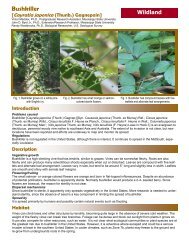RATopic1_95 - Geosystems Research Institute - Mississippi State ...
RATopic1_95 - Geosystems Research Institute - Mississippi State ...
RATopic1_95 - Geosystems Research Institute - Mississippi State ...
You also want an ePaper? Increase the reach of your titles
YUMPU automatically turns print PDFs into web optimized ePapers that Google loves.
Task 3.2 Distribution of Opuntia in the Region<br />
PI: Victor Maddox<br />
Co-PI: John Madsen, Richard Brown<br />
Collaborators: Randy Westbrooks, USGS NWRC; Joel Floyd, USDA APHIS PPQ; John C. Stewart, USDA APHIS PPQ<br />
Much of the host mapping activity in 2009 was focused<br />
along the Gulf Coast due to the discovery of<br />
cactus moth in southern Louisiana (Figure 1), although<br />
host mapping did occur elsewhere. Host data<br />
from 18 states was collected in 2009, including four<br />
new states, bringing the total number of states with<br />
host data in the CMDMN database to 36 (as of 14<br />
Dec 2009). In 2009, 1399 host data reports were<br />
collected and entered into the Cactus Moth Detection<br />
and Monitoring Network (CMDMN) database.<br />
The largest number of reports entered in 2009 were<br />
negative host reports at 1292 compared to 107 positive<br />
host reports for the same period as of 14 December<br />
2009. On 14 December 2009, there were<br />
10,030 reports in the CMDMN database with 2,678<br />
positive host reports and 7,352 negative reports.<br />
Distribution of Pricklypear Cactus<br />
Victor Maddox<br />
There is still a need for additional host mapping<br />
along the Gulf Coast which, in addition to visual<br />
cactus moth surveys in known infested areas and<br />
volunteer sentinel site activity, will be the focus of<br />
near-future project activities as funding permits in<br />
2010. The entry of numerous negative reports from<br />
the northwestern United <strong>State</strong>s continues and is expected<br />
to be completed in early 2010, adding data<br />
from new areas like the Great Basin Desert and Fish<br />
Lake National Forest (Figure 2).<br />
Figure 1. Cactus moth was discovered in the southern Louisiana<br />
bayous in Mid-2009. The blue dots on the CMDMN database map<br />
south of New Orleans indicate the location of the infestation. Red<br />
dots indicate locations with cactus but without the moth. This discovery<br />
has prompted increase activity in southern Louisiana.<br />
Figure 2. The entry of numerous negative reports from the northwestern United <strong>State</strong>s is expected to be completed in early 2010 and<br />
will eventually add data from new areas like the Great Basin Desert in Nevada (left) and Fish Lake National Forest (right) in Utah.<br />
2009 USGS Annual Report 22 <strong>Mississippi</strong> <strong>State</strong> University’s <strong>Geosystems</strong> <strong>Research</strong> <strong>Institute</strong>




